Understanding Morgue Freezer Systems
When funeral directors and medical facilities need to make informed decisions about body storage, morgue freezer pictures become invaluable resources. These visual references aren't just product photos—they're educational tools that help professionals understand the equipment that plays such a crucial role in their daily work.
I've spoken with countless funeral directors who initially felt uncertain about what to look for in proper refrigeration systems. That's why we created this straightforward guide to morgue freezer images that respects both the professionals who use this equipment and the deceased they care for.
| Type of Morgue Freezer | Key Features | Temperature Range | Capacity |
|---|---|---|---|
| Single-drawer units | Individual compartments, 304 stainless steel | 2°C to 6°C (36°F to 43°F) | 1 body |
| Multi-drawer cabinets | Stacked compartments, digital controls | -2°C to 5°C | 2-6 bodies |
| Walk-in coolers | Modular panels, body racks | 1°C to 5°C | 4-30+ bodies |
| Mobile/emergency units | Portable, generator backup | 0°C to 4°C | Varies |
Today's morgue refrigeration systems have come a long way from the basic cold rooms of decades past. The gleaming 304 stainless steel construction isn't just for appearance—it provides a durable, easy-to-sanitize surface that stands up to daily use. The polyurethane foam insulation (with an impressive R-32 rating) maintains steady temperatures while keeping energy costs manageable, something our Tennessee customers particularly appreciate during hot summers.
When browsing morgue freezer pictures, I always suggest focusing on practical elements that affect your daily operations. Notice how the doors seal completely to maintain temperature. Look at the interior tray systems and how bodies can be transferred smoothly and respectfully. Examine the control panels—are they intuitive and easy to read at a glance? And consider how the unit fits into your available space.
Here at American Mortuary Coolers, we've helped funeral homes from Georgia to New York find the right refrigeration solutions by providing clear, detailed morgue freezer pictures that show exactly what they're investing in. We believe that seeing is understanding when it comes to this specialized equipment.
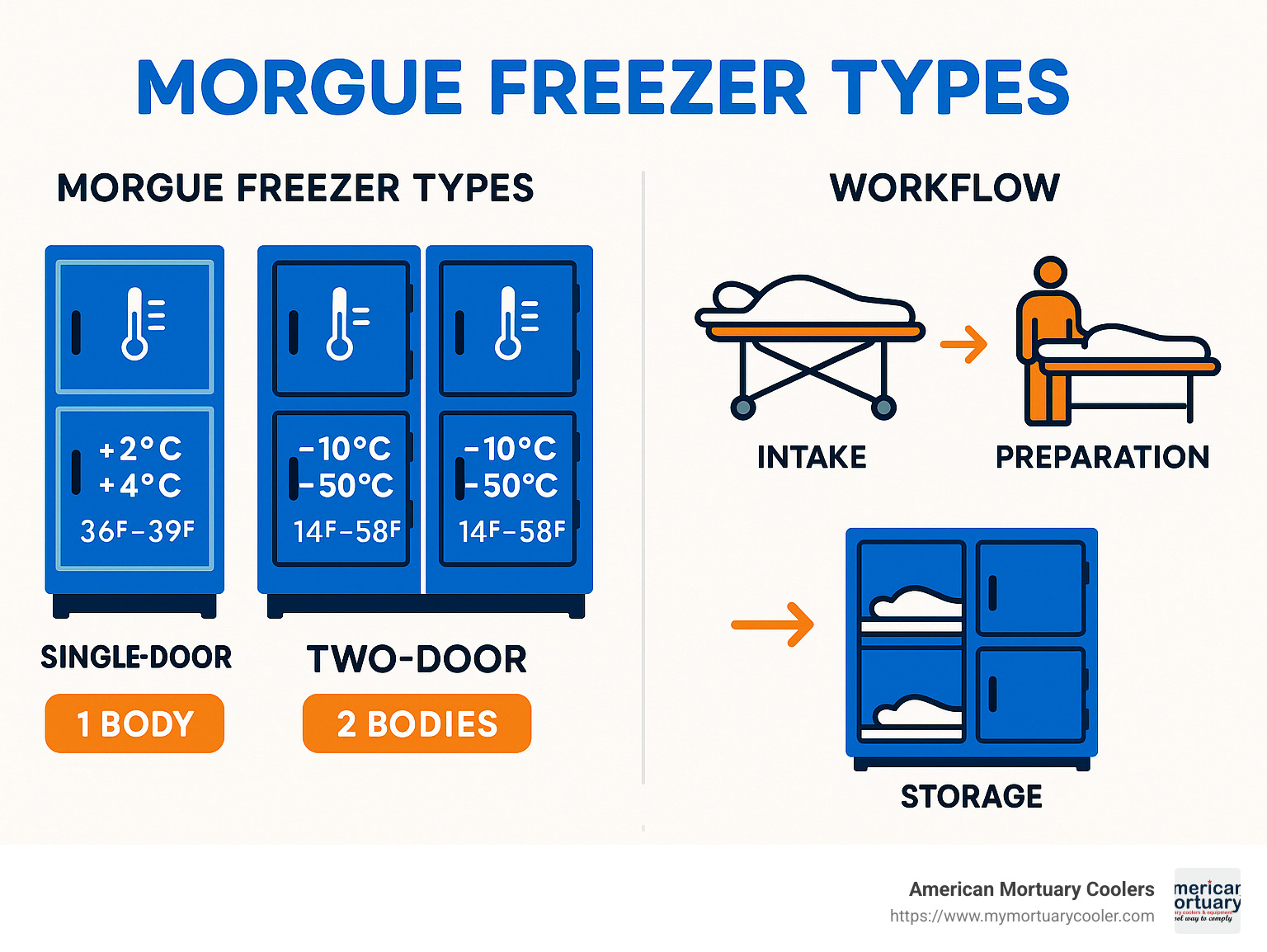
For those new to the industry, here are some common terms you'll encounter when researching morgue freezer pictures:
Why Visual References Matter
"I had no idea what I was looking for until I saw actual pictures," a funeral director from rural Tennessee told me last year. That's exactly why visual references of morgue freezers are so valuable in our industry.
For mortuary students and new staff, morgue freezer pictures offer a gentle introduction to equipment they'll soon use daily. These images create a mental blueprint that makes hands-on training less overwhelming. For facility managers planning renovations, visual references establish clear design benchmarks, making it easier to compare options and communicate needs to architects and suppliers.
Perhaps most importantly, accurate visual references help counter Hollywood's dramatized versions of morgue environments. One mortician with 30 years of experience put it simply: "The mortuary isn't really like what is shown on TV." Real morgue freezer pictures show the clean, organized, and respectful reality of modern facilities—a far cry from the eerie, flickering-light scenes in crime shows.
Our customers across the contiguous 48 states appreciate seeing exactly what they're getting before making such an important investment for their facilities.
Sensitivity & Ethics When Viewing morgue freezer pictures
There's a right way and a wrong way to approach morgue freezer pictures, and respect makes all the difference.
Professional photographs should focus on the equipment itself—the sleek stainless steel, the precision temperature controls, the durable construction. If bodies are present in educational images, dignity must be maintained through appropriate draping and anonymization. We believe that the deceased deserve the same respect in photographs as they do in person.
It's worth noting that some people may find these images challenging, even in professional contexts. That's why including a simple trigger warning is both considerate and professional when sharing morgue freezer pictures in educational materials or presentations.
Consent matters too. Images from working morgues should only be captured and shared with proper authorization from the facility, and always in compliance with regulations like HIPAA. As a company serving funeral homes nationwide, we're committed to respectful visual documentation that advances the profession while honoring those who have passed.
After all, the equipment we provide isn't just about refrigeration—it's about creating a dignified environment for those in our care, even if only for a short time.
1. Classic Single-Drawer Cooler Close-Up
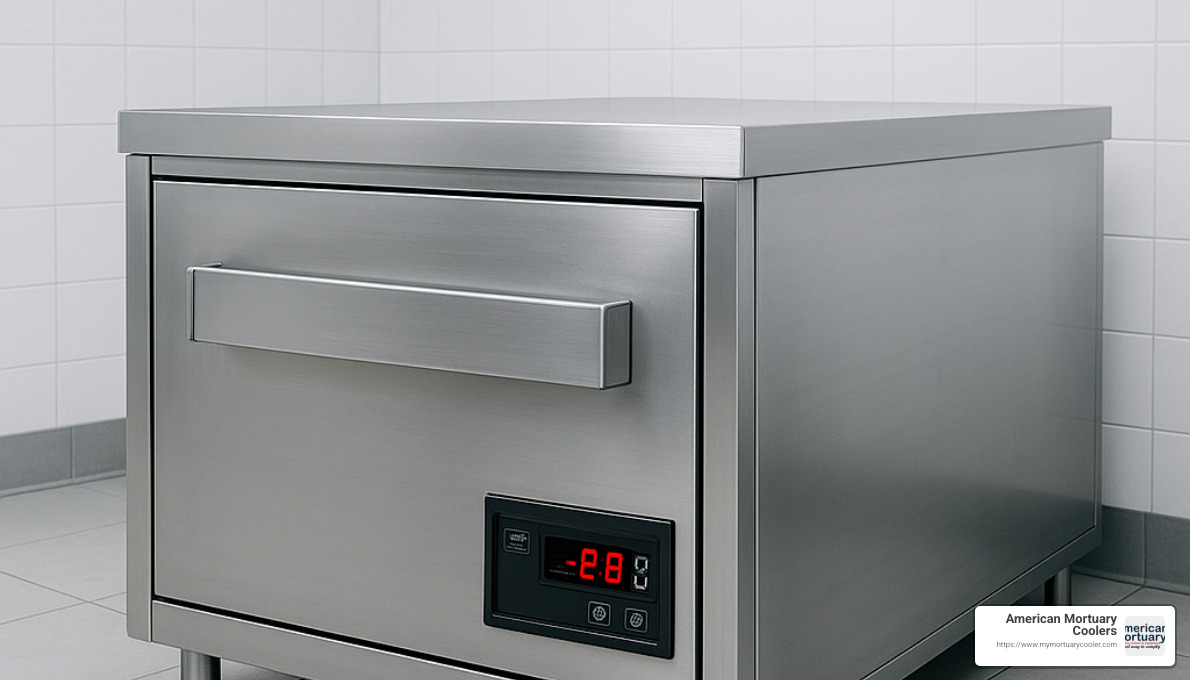
When you look at morgue freezer pictures, the single-drawer cooler is often what comes to mind first. It's the workhorse of mortuary refrigeration – simple, reliable, and perfectly designed for its purpose.
These individual compartments feature sleek, compartment-door designs that open smoothly and close with a reassuring seal. We craft ours from medical-grade 304 stainless steel, which isn't just about looking professional – this material naturally resists corrosion and creates an environment where bacteria struggle to gain a foothold. In the mortuary business, this level of hygiene isn't optional; it's essential.
Take a closer look at the digital display on modern units like ours. These aren't just for show – they give you instant temperature readings so you can verify proper conditions with just a glance. No more guesswork or manual thermometers. The ideal temperature range stays between 2°C and 6°C (36°F to 43°F), carefully calibrated to preserve without freezing tissues.
What really sets professional-grade units apart is the independent compressor system. As Jake from our Tennessee workshop likes to say, "It's like giving each drawer its own personal air conditioner." Unlike your kitchen refrigerator that cools everything with one system, our mortuary coolers use dedicated Danfoss compressors for each drawer. This means opening one compartment doesn't affect the temperature in others – a crucial feature when precision matters.
The doors deserve special mention too. We've all experienced that jarring sound of a slammed refrigerator door. In a space meant for dignity and respect, that's the last thing you want. Our units feature soft-close mechanisms and specialized gaskets that create a whisper-quiet, airtight seal when closed.
For smaller funeral homes or facilities just starting out, single-drawer units offer wonderful flexibility. They don't demand much floor space, and you can add more as your needs grow. It's a bit like building with blocks – start with what you need now and expand later.
Want to learn more about how bodies are actually stored within these systems? Our team has put together a detailed guide on morgue drawer storage practices that goes deeper into the practical aspects of body placement, trays, and handling procedures.
2. Double-Stack Hospital Unit in Use
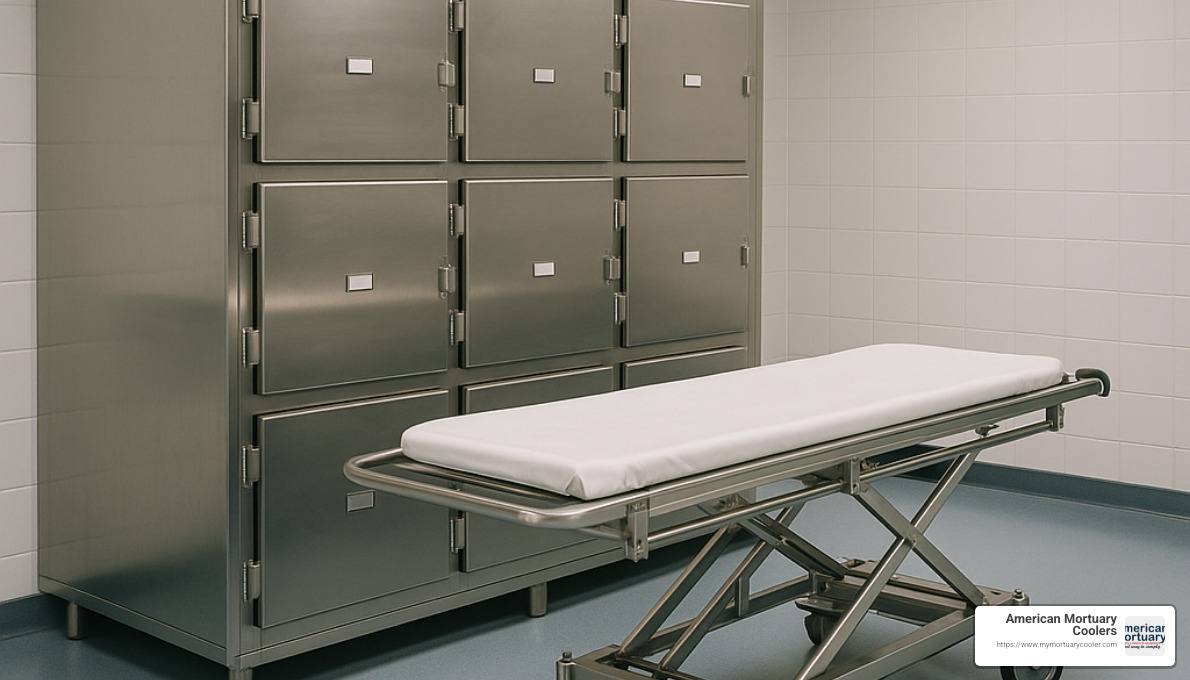
Walk into any busy hospital morgue and you'll likely spot one of these workhorses – the double-stack unit. These practical configurations have become the standard in medical facilities where space comes at a premium but dignity can't be compromised.
The beauty of these units lies in their thoughtful design. With two rows of compartments stacked vertically, hospitals can effectively double their capacity without expanding their footprint. What you can't see in the morgue freezer pictures is perhaps their most appreciated feature – the whisper-quiet operation that creates a respectful environment. Unlike the older models that hummed and vibrated noticeably, today's units run so quietly you might forget they're there.
"When families visit our facility, the last thing they need is the constant reminder of refrigeration equipment," one of our Tennessee clients told us recently. "These new double-stacks are practically silent."
The gurney transfer system is where engineering meets compassion. When a body arrives, staff can align their transport gurney directly with the extended refrigerated tray. Using a smooth-gliding transfer board, they can move the deceased with minimal handling – preserving dignity while reducing physical strain on workers. It's this attention to the transfer process that makes these units particularly valued in busy hospitals where staff safety matters as much as respectful handling.
Body trays themselves deserve special mention. Far from simple shelves, they feature concave designs to contain any fluids, reinforced edges to prevent bending, and smooth surfaces that make thorough cleaning possible. The roller systems allow even smaller staff members to open and close drawers effortlessly, regardless of weight.
At the foot of each tray, you'll notice a small but crucial detail – the foot-tag holder. This simple addition allows for quick identification without unnecessarily opening compartments. Staff can confirm identity at a glance, maintaining proper temperature while showing respect for the deceased.
Here at American Mortuary Coolers, we've delivered these double-stack units to hospitals throughout the Midwest and across the Northeast. Each installation is slightly different – adapted to fit the unique layout of the facility while maintaining the core features that make these units so reliable.
When hospitals share their morgue freezer pictures with us during the planning phase, we can customize these double-stacks to work perfectly with their existing gurney systems and workflow patterns. It's this kind of thoughtful integration that makes a world of difference in daily operations.
3. Compact Four-Body Cabinet for Small Facilities
For funeral homes and smaller medical facilities with limited space but multiple-body storage needs, the compact four-body cabinet offers an ideal solution. These space-saving units typically measure about 2280 × 2500 × 1785 mm externally while providing storage for four bodies in individual compartments.
The key to their thermal efficiency lies in the polyurethane foam insulation. Unlike older units that used fiberglass or extruded polystyrene, modern cabinets use high-density polyurethane foam with an impressive R-32 rating. This exceeds the R-25 minimum required by the Energy Independence and Security Act, ensuring excellent temperature stability while minimizing energy consumption.
Safety features are paramount in these units, with over-temperature alarm systems being standard. These alarms provide both audio and visual alerts when temperatures deviate from the set range, giving staff time to address issues before preservation is compromised. As one manufacturer notes, "Advanced temperature control systems maintain 2°C–6°C via efficient compressors, insulation, and digital displays."
Each compartment in these units is rated for a maximum load of 150 kg (approximately 330 lbs), accommodating most bodies while ensuring the long-term structural integrity of the drawer systems. The weight rating is particularly important for facilities that may need to store larger individuals or those with additional medical equipment.
The compact four-body cabinet represents the perfect middle ground between single units and walk-in coolers. They provide multi-body capacity without requiring the floor space, installation complexity, or higher costs associated with walk-in systems. For our customers in Columbia SC, Pittsburgh PA, and throughout the Southeast Region, these units often prove to be the most practical and cost-effective solution.
4. Walk-In Room Showing 16-Body Racking System
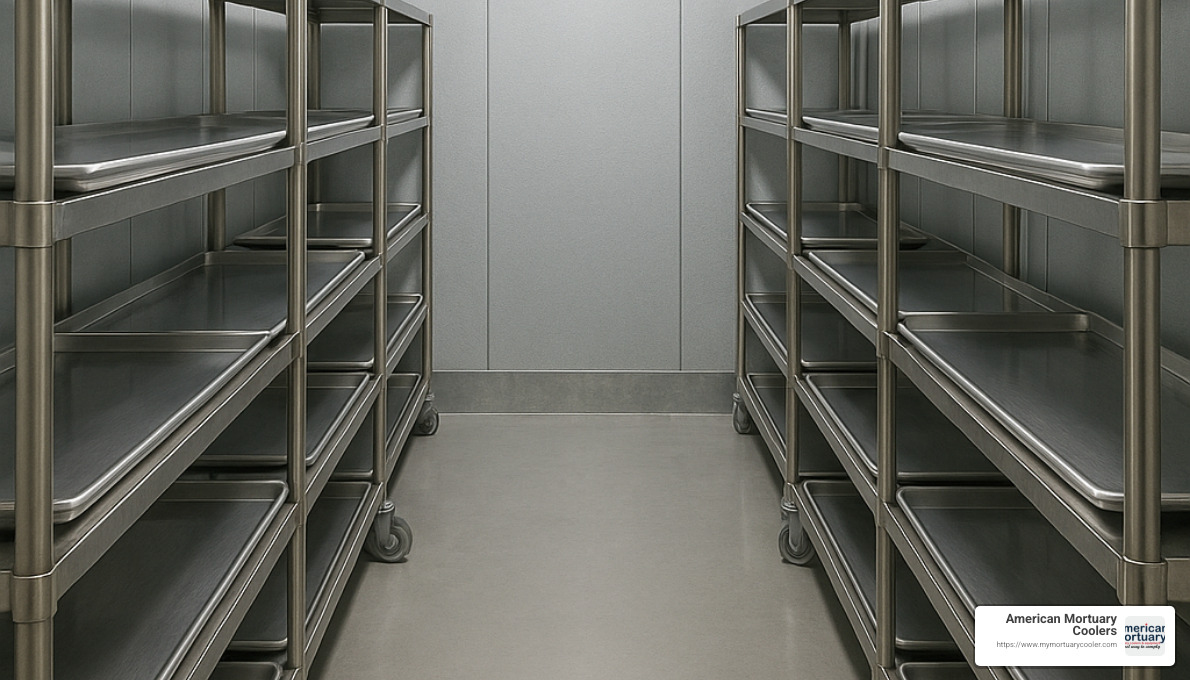
When funeral homes or medical facilities need substantial capacity, our walk-in coolers with 16-body racking systems become the gold standard. These impressive rooms are where function meets respect on a larger scale.
The beauty of these systems lies in their modular panels – think of them as sophisticated building blocks. "We can customize the size and configuration to fit almost any space," explains one of our Tennessee-based installation specialists. "And if your needs change, the system can change with you." This flexibility means you're never locked into a permanent solution that might not serve your future needs.
Our clients particularly appreciate the roll-in racks visible in quality morgue freezer pictures. These stainless steel marvels allow staff to prepare bodies in other areas of the facility before wheeling the entire rack into the cooler. This thoughtful design minimizes door-open time and helps maintain that crucial steady temperature inside.
The negative pressure system is another feature that sets professional-grade walk-ins apart. It's a subtle but important detail – when you open that heavy door, air flows inward rather than outward. This creates a natural barrier that contains odors and maintains proper respect for both the deceased and those working nearby.
Look down at the floor in these morgue freezer pictures and you'll notice something special – anti-microbial flooring that's both practical and protective. These seamless surfaces resist bacterial growth while standing up to heavy traffic, rolling equipment, and the rigorous cleaning protocols necessary in this environment.
"We installed a walk-in system for a county facility in Georgia last year," shares our lead designer. "They needed capacity for disaster response but wanted something that felt respectful, not industrial. The panoramic view of the finished room shows how we balanced both needs."
At American Mortuary Coolers, we've created custom walk-in systems from New York to California, each one custom to the specific needs of the community it serves. The 16-body configuration has become particularly popular for mid-sized operations that need flexibility without excessive capacity.
5. High-Resolution Morgue Freezer Pictures for Training
Teaching laboratories and pathology programs rely on high-quality visual references of morgue freezers to prepare students before they enter actual facilities. These educational morgue freezer pictures are specifically composed to highlight key features and operational aspects of the equipment.
HD lighting techniques are essential when capturing these images for training purposes. Professional photographers use balanced, high-color-rendering-index lighting to accurately represent the true colors and textures of stainless steel surfaces, control panels, and other equipment details. This precision is crucial for students learning to identify different components and potential issues.
Labeling protocols are often prominently featured in these educational images. Students need to understand the standardized systems used for identifying bodies, tracking storage locations, and maintaining proper documentation. These protocols may include color-coded tags, barcode systems, or alphanumeric drawer identifiers that help maintain organization in busy facilities.
For those seeking additional high-quality visual references, Getty Images maintains an extensive morgue refrigerator gallery with professionally photographed examples suitable for educational and reference purposes.
When we provide training for new customers at American Mortuary Coolers, we include comprehensive visual guides that show proper operation, maintenance procedures, and best practices for their specific equipment. These materials have proven invaluable for facilities with staff turnover or those implementing new protocols.
6. Emergency Mobile Morgue Trailer Setup
Disaster response situations require specialized mortuary solutions that can be rapidly deployed to affected areas. Mobile morgue trailers have become essential components of emergency preparedness, providing dignified temporary storage when local facilities are overwhelmed or damaged.
These units feature generator backup systems that ensure continuous operation even when local power infrastructure is compromised. The generators are typically diesel-powered with sufficient fuel capacity for 72+ hours of autonomous operation, with easy refueling access for extended deployments.
Wheel locks and stabilization systems are critical for safe operation. Once positioned, these mobile units must be completely stable to allow for the safe transfer of bodies and prevent any movement that could damage the refrigeration systems or disturb the deceased.
The rapid deployment capability of these units is achieved through standardized designs and pre-configured systems. Many can be operational within hours of arrival on-site, providing immediate relief to overwhelmed local resources. This quick response time is crucial during mass-casualty incidents, natural disasters, or public health emergencies.
Essential accessories for mobile morgue deployments include:
- Portable ramps for gurney access
- External weather protection canopies
- Supplemental lighting systems
- Secure documentation stations
- PPE storage and disposal units
- External fuel monitoring systems
During the COVID-19 pandemic, mobile morgue units became unfortunately familiar sights in many communities. Their presence highlighted both the severity of the crisis and the importance of dignified body handling even in emergency situations. At American Mortuary Coolers, we provided several emergency units to hospitals in Chicago IL, New York NY, and other heavily impacted areas, working around the clock to meet the sudden surge in demand.
7. Forensic Autopsy Suite with Adjacent Freezer Wall
When we visit forensic facilities, we're often struck by how thoughtfully the autopsy areas connect with body storage. Morgue freezer pictures that capture this integration show something the public rarely sees - a carefully designed workspace where respect for the deceased meets scientific precision.
At the heart of these spaces sits the autopsy table, typically positioned centrally with the freezer wall just steps away. This isn't random - this arrangement minimizes movement of the deceased, preserving evidence integrity and reducing physical strain on staff. Modern autopsy tables feature built-in drainage systems that direct fluids away safely, height adjustments for different examiners, and specialized surfaces that stand up to the powerful disinfectants used between cases.
Look closely at these facilities and you'll notice transparent splash guards mounted strategically on walls. These protective shields prevent contamination of surrounding areas, especially near sinks and work surfaces. Made from materials that can withstand frequent cleaning with harsh chemicals, they're an unsung hero in maintaining a safe environment.
One feature our customers particularly appreciate in these integrated spaces is hands-free door access. Whether it's foot pedals you press with your shoe, motion sensors that detect your approach, or simple push-plates you bump with your elbow, these mechanisms allow staff to move between areas without compromising sterility. As one medical examiner told us, "The last thing you want is to have to touch a handle with gloves that have been involved in an autopsy."
PPE stations stand ready throughout these facilities, strategically placed at entrances and transition areas. These stations provide the full armor of protection: gowns, face shields, masks, and other items staff need before beginning their work.
Glove dispensers deserve special mention too. They're mounted everywhere you might need them - by doorways, near sinks, beside examination areas. As one of our mortuary professionals in Nashville once said with a smile, "In this business, you can never have too many gloves. We place them everywhere so staff never have to reach far for protection. If one box runs out, another is immediately available."
At American Mortuary Coolers, we've worked with forensic facilities throughout the Rocky Mountain and Southwest regions to create these integrated systems. Each facility has unique needs based on their caseload, space constraints, and workflow preferences. Whether designing a new facility in Colorado Springs or upgrading an existing one in Phoenix, we focus on creating environments that support both scientific precision and dignified care of the deceased.
8. Temperature Monitoring Dashboard Screenshot
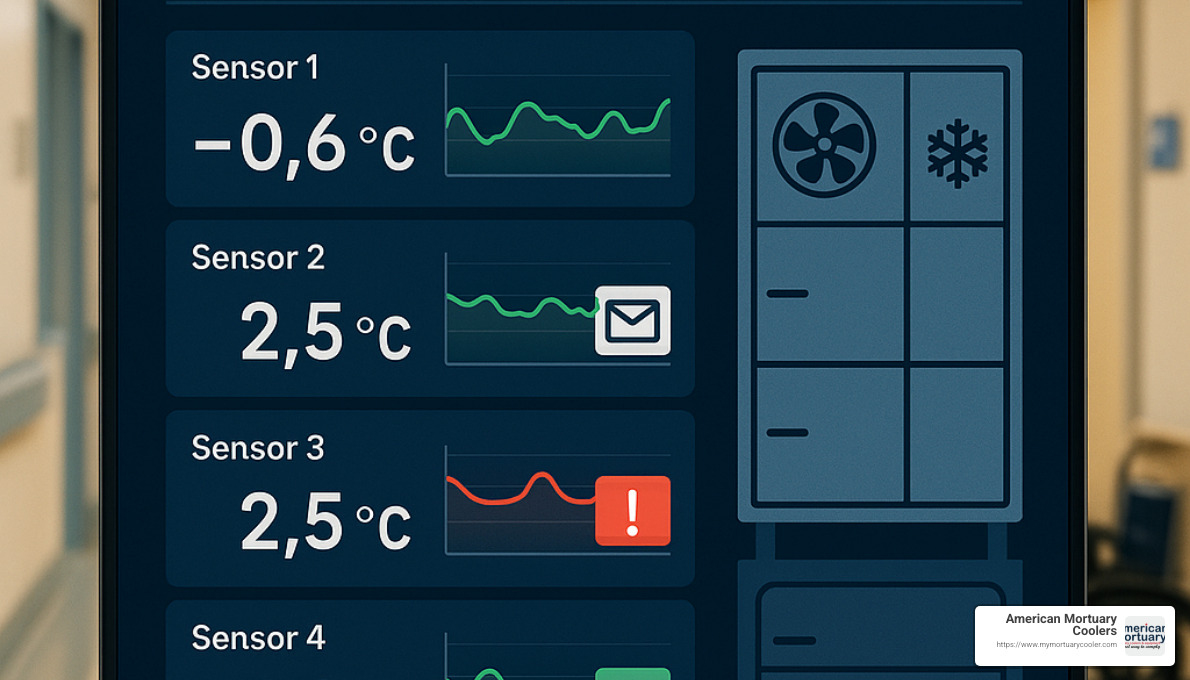
Gone are the days of walking into the cooler room to check a wall thermometer. Today's morgue freezer pictures often showcase impressive digital monitoring systems that keep a watchful eye on your precious cargo 24/7.
These modern systems rely on a network of sensors strategically placed throughout the refrigeration unit. Rather than just measuring one spot and hoping for the best, we now get a comprehensive temperature map of the entire space. At American Mortuary Coolers, we've found this approach eliminates those pesky "cold spots" that used to plague older units.
"My staff used to manually log temperatures three times a day," one funeral director in Tennessee told us. "Now our system records readings every minute and stores a complete history. It's like having an extra employee who never takes vacation!"
The data logger component is the heart of these systems. It faithfully records temperature data every few minutes, creating a detailed history that's invaluable when questions arise. Most of our systems store this information for at least a year, giving you peace of mind and a solid paper trail for inspections.
Perhaps the most appreciated feature is the SMS alarm capability. When temperatures drift outside acceptable ranges, these systems immediately text designated staff members. This means someone can respond quickly, whether it's 2 PM or 2 AM. For smaller funeral homes without round-the-clock staffing, this feature has been nothing short of revolutionary.
The compliance records generated by these systems have become increasingly important as regulatory oversight has tightened. When an inspector shows up unannounced (as they tend to do), you can quickly produce verifiable documentation showing your commitment to proper care.
Comparing Old vs. New Monitoring Approaches:
| Feature | Analog Systems | Digital Systems |
|---|---|---|
| Reading accuracy | ±1-2°C | ±0.1°C |
| Data recording | Manual logs | Automatic continuous recording |
| Alert system | None or basic | Real-time SMS/email notifications |
| Compliance reporting | Manual | Automated with export options |
| Temperature mapping | Single point | Multiple sensors throughout unit |
| Remote monitoring | Not available | Web/mobile app access |
| Cost | Lower initial investment | Higher initial cost, lower long-term labor |
At American Mortuary Coolers, all our modern units come standard with digital monitoring systems. We've installed these throughout our service areas, from busy metropolitan facilities in Atlanta to small family-owned funeral homes across the Pacific Region. For customers with older equipment, we offer straightforward retrofitting options to bring your monitoring capabilities into the 21st century without replacing your entire system.
As one customer put it: "I can finally sleep through the night without worrying about my cooler. The system watches it for me, and only calls when there's something I need to know about."
9. Decommissioned Cold Room from Urban Exploration
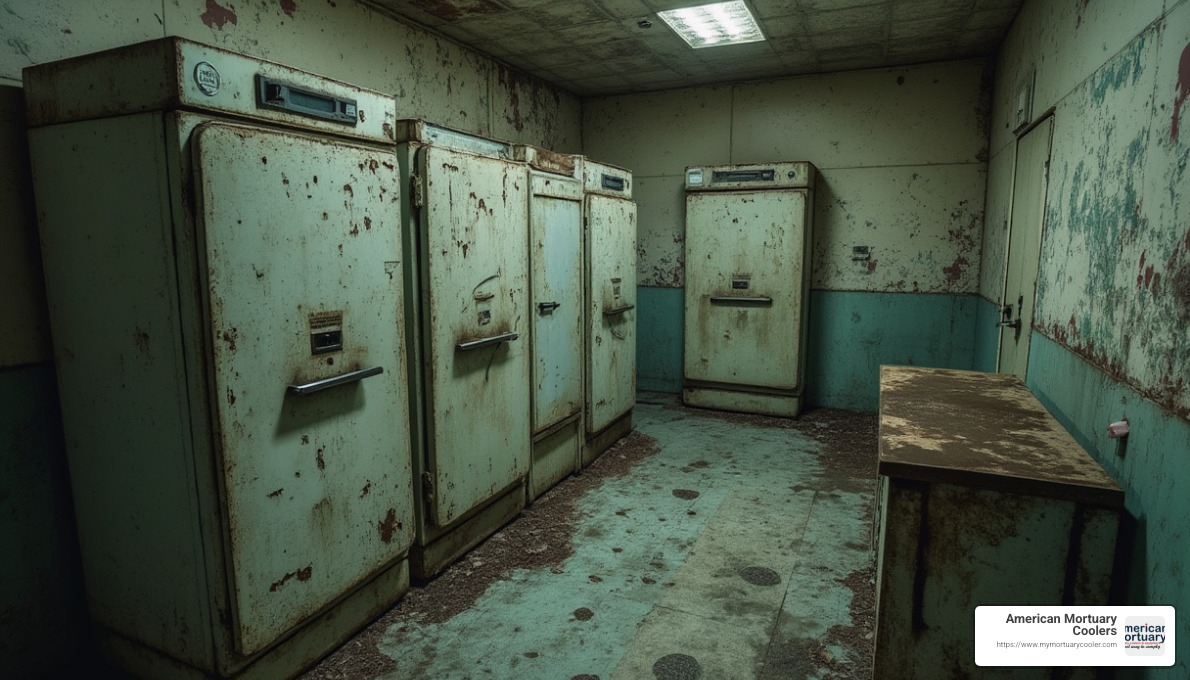
There's something hauntingly beautiful about abandoned morgue facilities. Urban explorers with cameras have created an unexpected niche of morgue freezer pictures that tell stories of our past and how we once cared for the deceased.
When I first saw images of these forgotten spaces, I was struck by the rich rust patina that develops on older units. Unlike today's medical-grade 304 stainless steel that we use at American Mortuary Coolers, many facilities from the 1950s and 60s used carbon steel with simple paint coatings. Once abandoned and exposed to humidity, these surfaces transform into canvases of orange and brown oxidation that urban photographers find irresistible.
The peeling paint in these spaces reveals layers of institutional colors – often pale greens and blues that were once thought to create a calming environment. It's fascinating to see how these choices contrast with modern design preferences for bare stainless steel surfaces that are easier to sanitize and more resistant to microbial growth. Each flake of paint represents a small piece of mortuary history.
What these spaces offer beyond their visual appeal is valuable historical context. You can trace the evolution of refrigeration technology through these images – from manual temperature dials to early digital displays, from mechanical latches to pneumatic door systems. One urban explorer noted in their caption: "The old control panel still had handwritten temperature logs from 1978 taped beside it. Someone's final duty before they closed this place for good."
For those interested in this unique intersection of history, photography and mortality, the Freezer Archives from PROJ3CTM4YH3M Urban Exploration offer a thoughtfully curated collection. The photographer behind this archive approaches these spaces with respect, noting about one location: "No info on this one, just another abandoned Morgue… Enjoy!"
While we at American Mortuary Coolers focus on crafting state-of-the-art equipment for today's funeral professionals, I find these historical images valuable reminders of how far our industry has come. The improvements in temperature control, energy efficiency, and dignified body handling over the decades are truly remarkable. These ghostly morgue freezer pictures help us appreciate the advances that now allow for more respectful care of the deceased.
10. Custom Six-Body Unit Ready for Shipment
The final stage before a morgue freezer reaches its destination is the careful preparation for shipment. Morgue freezer pictures documenting this phase reveal the extensive measures taken to ensure these sensitive pieces of equipment arrive in perfect condition.
Crating for morgue freezers involves far more than standard packaging. Custom-built wooden structures are constructed around the units, with precision-cut foam inserts that secure components and prevent movement during transit. Larger units may be partially disassembled, with each component individually wrapped and labeled for efficient reassembly at the destination.
Quality inspection processes are rigorous before any unit leaves the manufacturing facility. As one manufacturer explains: "All walk-in units are fully test-assembled in-plant before shipment to ensure problem-free on-site installation." This practice means that every component is verified to work correctly before being disassembled for shipping, significantly reducing installation issues at the final location.
CE certification marks are visible on units destined for international markets, indicating compliance with European health, safety, and environmental protection standards. These certifications are increasingly important as mortuary equipment moves through global supply chains and must meet varying regional requirements.
Forklift pockets integrated into the base of larger units are an important feature visible in shipping preparation images. These reinforced channels allow for safe lifting and positioning during loading, unloading, and installation without risking damage to the refrigeration components or exterior finish.
At American Mortuary Coolers, we take particular pride in our shipping preparation process. Our six-body units manufactured in Johnson City TN are thoroughly tested, carefully packaged, and delivered directly to customers throughout our service regions. This direct delivery approach minimizes handling and ensures that each unit arrives in perfect condition, ready for immediate installation.
For an inside view of our shipping preparation process, you can see how we ensure that even our largest units are protected during transit to facilities across the contiguous 48 states.
Frequently Asked Questions about morgue freezer pictures
How are bodies organized inside morgue freezers?
The organization inside a morgue freezer is far more sophisticated than most people realize. Modern facilities use thoughtful systems that balance efficiency with dignity for the deceased.
Drawer indexing forms the backbone of this organization. Each compartment gets its own unique identifier – sometimes alphabetical, numerical, or a combination of both. This simple but effective system helps staff quickly locate specific individuals when needed, reducing the time doors remain open and maintaining stable temperatures.
In larger facilities, you'll often find barcode ID systems that bring mortuary organization into the digital age. When someone comes into our care, they receive a barcode tag that's scanned whenever they're moved or accessed. This creates a digital trail that eliminates mix-ups and provides peace of mind for everyone involved. We typically place these barcodes on both the body tag and the drawer itself – redundancy is key when accuracy matters this much.
The physical spacing within these units requires careful consideration too. At American Mortuary Coolers, we design our standard drawer heights between 8-12 inches (20-30 cm), which accommodates most needs while maximizing capacity. We always include a few larger compartments for special situations as well. Our trays are engineered to support up to 330 pounds (150 kg) safely, which influences both the spacing and structural elements of our storage systems.
When we work with funeral homes across Tennessee or medical facilities in Georgia, we always customize the internal configuration to match their specific community needs. No two facilities are exactly alike, and their coolers shouldn't be either.
What temperature do morgue freezers maintain?
Temperature control is the heart and soul of what we do at American Mortuary Coolers. Despite the name "freezer" being commonly used, most units are actually refrigerators, not freezers at all.
Standard morgue coolers maintain temperatures between 32°F and 41°F (0°C to 5°C). This sweet spot slows decomposition significantly without actually freezing tissues, making it perfect for short to medium-term care. The majority of our customers throughout New York and across the country use this temperature range for their daily operations.
For special circumstances or long-term storage, true deep-freeze units operating at 5°F (-15°C) or colder may be necessary. While these colder temperatures further slow biological processes, they can cause tissue damage from ice crystal formation, which might complicate later examination or embalming. That's why most facilities only use deep-freezing when absolutely necessary.
Compressor cycling is how we maintain these precise temperatures. Rather than running continuously (which would waste energy and wear out components prematurely), our refrigeration systems gently cycle on and off based on feedback from highly sensitive temperature sensors. Our modern units maintain temperature within half a degree of the set point – precision that matters when preservation is the goal.
One feature our customers particularly appreciate is that each compartment in our multi-drawer units has its own dedicated compressor and control system. This independent regulation allows different drawers to be set at different temperatures if needed, providing the flexibility that busy facilities require.
Are there legal limits on sharing morgue freezer pictures online?
The sharing of morgue freezer pictures walks a fine line between educational value and respect for privacy – with several important legal guardrails in place.
HIPAA regulations protect the privacy of health information even after death. This means medical facilities and their staff cannot share images that might identify a deceased person without proper authorization. Even when the focus is meant to be the equipment itself, facilities must be extremely careful about what might appear in the background.
When families are involved, obtaining next-of-kin permission becomes essential for any photography that might include identifiable remains. Most of the funeral homes we work with across the country have strict policies that prohibit photography entirely except for specific authorized purposes like documentation for medical or legal records.
There are narrow editorial use exemptions that sometimes apply – such as journalistic coverage of disasters or historical documentation. However, these exceptions require careful consideration of whether public interest truly outweighs privacy concerns.
For those needing to share morgue freezer pictures appropriately, we recommend these common-sense guidelines:
- Always focus on empty equipment when possible
- Get written facility permission before taking any photographs
- Never include identifying features of the deceased
- Consider cultural and religious sensitivities regarding death
- Ensure there's genuine educational or informational value
At American Mortuary Coolers, we maintain a library of equipment photographs that strictly follow these guidelines. We either photograph completely empty units or occasionally use mannequins for demonstration purposes. This approach allows us to educate customers about our products while maintaining the highest standards of respect and dignity that our industry demands.
Conclusion
Quality morgue freezer pictures offer more than just visual information – they tell the story of how our industry cares for those who have passed. When funeral directors and medical facilities look through these images, they're not just shopping for equipment; they're seeking reassurance that they're providing the best possible care during a sensitive time.
The evolution of morgue refrigeration systems reflects our growing commitment to dignity and respect. Modern designs prioritize quiet operation, gentle handling mechanisms, and discreet appearances that create a more comforting environment for both staff and visiting family members. Through thoughtful visual documentation, we can see how far we've come from the clinical, institutional designs of decades past.
What strikes me most when reviewing today's morgue freezer pictures is how technology now serves the human element of our work. Temperature monitoring systems send alerts directly to staff phones, ensuring someone responds quickly if issues arise – even in the middle of the night. Drawer systems operate smoothly with minimal noise, showing respect even in these small details. Antimicrobial surfaces protect both the living and the deceased.
Here at American Mortuary Coolers, we take tremendous pride in crafting solutions that meet the unique needs of each facility we serve. Our Tennessee craftspeople understand that a morgue cooler for a small-town funeral home in Georgia has different requirements than one for a busy metropolitan hospital in New York. We build each unit with that specific purpose in mind, then deliver it directly to your doorstep anywhere in the contiguous 48 states.
We believe that quality equipment supports quality care. When a family entrusts their loved one to your facility, they deserve the peace of mind that comes from knowing you've invested in proper preservation systems. Our coolers provide that reassurance through reliable performance year after year.
If you're considering upgrading your current refrigeration system or outfitting a new facility, we invite you to explore our guide to Cold Storage Solutions: Top Morgue Freezers Available Today. It offers practical advice for selecting the right solution for your specific circumstances.
Thank you for taking the time to learn more about this essential but seldom-discussed aspect of funeral service. By approaching this topic with professionalism and care, we hope to have honored the important work you do in your community every day.
















